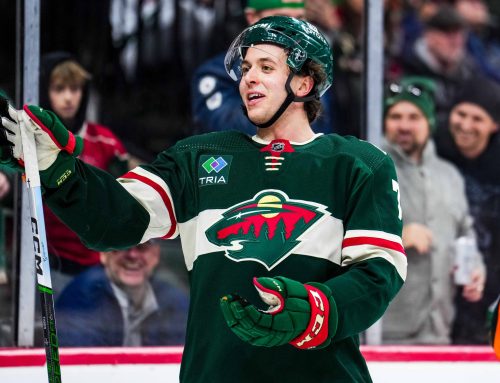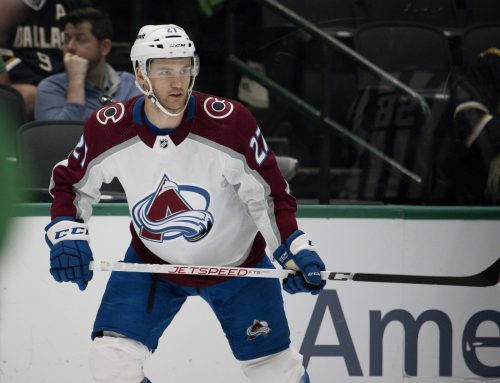
Two defensemen off to fast starts are featured in this week's Cage Match.
Last season only 23 defensemen posted 40+ points, but nearly as many (19) finished with 35-39. That makes it crucial to determine which rearguards will indeed reach 40+ points, versus those who’ll be stuck just below the threshold. With that in mind, this week we’re pitting Jake Muzzin against Jared Spurgeon. Muzzin had consecutive 40+ point seasons before cratering to 28 in 2017-18, while Spurgeon has never posted 40+ but had a 41-point scoring pace (38 points in 76 games) in 2016-17. Who’s got the better chance at 40+ this season, and beyond? Cage Match is here to find out!
Career Path and Contract Status
Muzzin, 28, was drafted 141st overall in 2007 but didn’t log a full NHL season until 2013-14, after maxing out junior eligibility and then 150 AHL contests (60 total points) spread over three seasons. So chances are LA wasn’t counting on him for great things. Still, Muzzin had 24 points in 2013-14, then consecutive 40+ point seasons in 2014-15 and 2015-16, making him one of only 19 rearguards to do so. Last season though, his output plummeted back to 28 points, leading poolies to figure his successful run was over. Yet this season he started hot (11 points in 15 games), which is intriguing since in each of his two 40+ point campaigns he emerged identically ice cold with zero points in his first seven games.
Spurgeon, who turns 28 in two weeks, was a similarly later pick (156th) in 2008, yet he made it to the NHL for good by 2011-12 (posting a modest 23 points in 70 games). His next three campaigns were injured plagued but saw him produce at a collective 31-point scoring pace. He finally played nearly an entire season in 2014-15, but took a step back in finishing with only 29 points. Then in 2016-17 he made the leap into point per every other game territory, giving poolies hope of a later career mini-breakout of sorts, further fueled by a hot start (10 points in 13 games) to 2017-18.
Both are signed through 2019-20, with Muzzin’s $4M cap hit a better than 20 percent bargain per season versus Spurgeon’s $5.187M.
Ice Time
|
Season |
Total Ice Time per game (rank among team’s forwards) |
PP Ice Time per game (rank among team’s forwards) |
SH Ice Time per game (rank among team’s forwards) |
|
2016-17 |
22:17 (J.M.) – 2nd 24:01 (J.S.) – 2nd |
2:25 (J.M.) – 2nd 2:14 (J.S.) – 3rd |
2:09 (J.M.) – 4th 2:10 (J.S.) – 2nd |
|
2015-16 |
23:03 (J.M.) – 2nd 22:40 (J.S.) – 2nd |
2:18 (J.M.) – 2nd 1:46 (J.S.) – 4th |
2:31 (J.M.) – 2nd 1:45 (J.S.) – 3rd (tied) |
|
2014-15 |
22:31 (J.M.) – 3rd 22:37 (J.S.) – 3rd |
2:33 (J.M.) – 3rd 2:01 (J.S.) – 2nd |
0:55 (J.M.) – 5th 2:10 (J.S.) – 3rd |
|
2013-14 |
19:01 (J.M.) – 4th 22:38 (J.S.) – 3rd |
2:24 (J.M.) – 3rd 2:07 (J.S.) – 2nd |
0:26 (J.M.) – 7th 2:01 (J.S.) – 3rd |
Why the change in total ice time for Spurgeon last season, and will it continue? It was the effect of Mike Yeo’s departure, and as such it should last. As we’re seeing in St. Louis this season, and as poolies witnessed for many years in Minnesota, Yeo leans on one defensemen so heavily it lessens the ice time of others, even those as capable as Spurgeon.
With Yeo gone last season, already it began to pay dividends for Spurgeon in total ice time. He also saw his ice time with the man advantage rise by nearly 30 seconds to its highest level in these four seasons, although unfortunately he recaptured nearly identical shorthanded Time. Still, this at least provides justification as to why his points suddenly jumped last season, although the extent of the jump seems high even in view of the ice time changes, so we’ll see if his production was boosted by unsustainable factors.
Looking at Muzzin’s data, you’d have a hard time seeing how he could’ve dropped to 28 points last season. He did shed some overall ice time; but a decent chunk was in the form of unproductive penalty killing duty, and he even somehow managed to gain power-play time as compared to 2015-16. The answer also doesn’t lie with the Kings as a team, as although their scoring slid, it was only by 10 percent versus the two prior seasons when he scored 40+ points, which doesn’t account for Muzzin shedding 30 percent of his scoring.
Plus, it wasn’t as though Muzzin posted 40+ just once, which could be more easily dismissed as a fluke. He hit the mark two times, and in both cases with ice time data essentially equivalent to his 2016-17 numbers. We’ll see if the answer lies with other metrics, since as of now things are not adding up.
Secondary Categories
|
Season |
PIMs (per game) |
Hits (per game) |
Blocked Shots (per game) |
Shots (per game) |
PP Points (per game) |
|
0.56 (J.M.) 0.26 (J.S.) |
1.97 (J.M.) 0.64 (J.S.) |
1.48 (J.M.) 1.84 (J.S.) |
2.24 (J.M.) 1.89 (J.S.) |
0.12 (J.M.) 0.06 (J.S.) |
|
|
2015-16 |
0.78 (J.M.) 0.18 (J.S.) |
2.40 (J.M.) 0.66 (J.S.) |
1.64 (J.M.) 2.04 (J.S.) |
2.47 (J.M.) 1.58 (J.S.) |
0.16 (J.M.) 0.17 (J.S.)
📢 advertisement:
|
|
2014-15 |
0.26 (J.M.) 0.09 (J.S.) |
2.42 (J.M.) 0.71 (J.S.) |
1.40 (J.M.) 1.85 (J.S.) |
2.25 (J.M.) 1.91 (J.S.) |
0.18 (J.M.) 0.09 (J.S.) |
|
2013-14 |
0.76 (J.M.) 0.24 (J.S.) |
2.22 (J.M.) 1.18 (J.S.) |
1.08 (J.M.) 1.59 (J.S.) |
2.30 (J.M.) 1.33 (J.S.) |
0.06 (J.M.) 0.10 (J.S.) |
Muzzin is the more complete multi-cat option, although that probably shouldn’t come as a surprise to most poolies. Note, however, that Spurgeon has consistently outproduced Muzzin in blocks.
For Muzzin, here too we see numbers in 2016-17 for shots on goal and power-play points that don’t differ nearly enough from his 2014-15 and 2015-16 outputs to explain his 30 percent scoring drop. So unless luck metrics tell a very clear story, signs are more and more pointing to last year as an unsustainable fluke and 2014-15 and 2015-16 as closer to Muzzin’s norm.
For Spurgeon, the focus has to be on power-play points, as somehow his rate dropped by nearly two-thirds from 2015-16 to 2016-17 despite his scoring pace increasing. The fact that he still posted 38 points notwithstanding such poor power-play output bodes well for what he could do if, for example, he’s able to revert to his 2015-16 production with the man advantage; however, him doing so poorly on the PP last season despite seeing more minutes could make it less likely for the team to lean on him as much in that area.
Luck-Based Metrics
|
Season |
Team Shooting % (5×5) |
Individual Points % (IPP) |
Offensive Zone Starting % (5×5) |
Secondary Assists % |
|
2016-17 |
6.36% (J.M.) 9.39% (J.S.) |
37.3% (J.M.) 36.2% (J.S.) |
53.5% (J.M.) 50.0%(J.S.) |
52% (J.M.) 43% (J.S.) |
|
2015-16 |
6.12% (J.M.) 7.91% (J.S.) |
47.6% (J.M.) 32.2% (J.S.) |
56.2% (J.M.) 54.2% (J.S.) |
53% (J.M.) 55% (J.S.) |
|
2014-15 |
6.54% (J.M.) 7.78% (J.S.) |
51.9% (J.M.) 39.7% (J.S.) |
57.1% (J.M.) 51.7% (J.S.) |
61% (J.M.) 43% (J.S.) |
|
2013-14 |
6.57% (J.M.) 9.50% (J.S.) |
42.1% (J.M.) 35.6% (J.S.) |
58.1% (J.M.) 52.3% (J.S.) |
52% (J.M.) 38% (J.S.) |
Seeing Muzzin’s individual points percentage helps somewhat demystify his slump from last season, since if we add 10 percent to his total if LA had scored as many goals as in 2014-15 or 2015-16, plus adjust his IPP back up to past levels, then we at least get into the 35-point range. So last year was indeed a fluke, and Muzzin should be a safe bet for at least 35+ points until his role changes or his game slows, and more if LA’s offensive improves.
Muzzin’s team shooting percentage is a concern. While being able to twice post 40+ points despite such a low number can be viewed as a positive, there could come a time when LA determines the very, very low team shooting percentage associated with Muzzin being on the ice might mean they have to deemphasize his role in offensive situations. In the era when teams look at “fancy stats” like this, it’s a worrisome issue.
For Spurgeon, nothing really stands out. His individual points percentage, offensive zone starting percentage and secondary assists rates were all within past ranges. Although his team shooting percentage was high last season, it had been even higher once in the past, making it less unsustainable to see it above that level again. In short, Spurgeon’s luck metrics suggest he could post 0.5 points per game again.
2017-18 Early Returns
Both players stormed out of the gates with superb production that put them well above 40+ point pace. In Muzzin’s case, he’s shooting the puck a lot more and his team shooting percentage is even lower than in past seasons, suggesting room for higher scoring. Unfortunately, these positives are countered by his power-play usage percentage being down 20 percent as compared to past seasons and his individual points percentage being a forward-like (and thus unsustainable) 60 percent. Still though – given his banked points and the fact that he’s seeing upwards of 23 minutes per game – he should have a great shot at another 40+ point campaign.
Spurgeon is seeing over a minute more ice time per game than last season and, for the first time ever, is taking the ice for more than 50 percent of Minnesota’s total power-play time. Yet his shots on goal rate and offensive zone starting percentage are essentially unchanged; and although his team shooting percentage is a bit low for him at barely 8 percent, he too has a grossly inflated individual points percentage (62.5%), which is the metric most tied to points. But like Muzzin, between points already scored and how things are set up to unfold, 40+ points is realistic.
Who Wins?
Picking a winner of this match underscores just how difficult it can be to differentiate a 35-39 point rearguard from one who’ll hit 40+. In the end, I’m going with Muzzin. For one, he’s already posted 40 points not once but twice, and there is ample enough evidence that last season’s 28 points was indeed aberrational. Also, between Muzzins’s lower-than-usual team shooting percentage, his uptick in shots on goal, and his slightly less outrageously high individual points percentage versus his past IPPs, I think he’ll come back to earth with less of a thud than Spurgeon.
All that having been said, Spurgeon’s role in Minnesota is growing and he should see enough ice time under the right circumstances for him to have a shot at 40 points most seasons, even if he likely will fall short due to shooting less than Muzzin, having a lower offensive zone starting percentage, not being a proven power-play contributor, and normally having a lower individual points percentage.
What should you do if you own either player? Holding is fine, since chances are you’ll get production at least as good as what you paid for, if not better. On the other hand, you also can’t be faulted for trying to leverage their hot starts to try to turn them into a younger d-man who might not be poised to outpoint either one this season, but could do so in a year or two and then in many seasons to come, such as a player like Noah Hanifin or Hampus Lindholm.





 WSH
WSH CAR
CAR WPG
WPG DAL
DAL TOR
TOR DET
DET MIN
MIN EDM
EDM VGK
VGK FLA
FLA CHI
CHI
